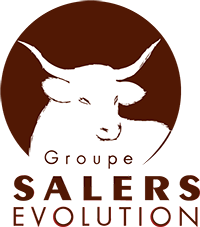Salers are the only breed in France producing beef by the suckler system as well as being milked for cheese production.
There exists therefore two sections of the breed : the Suckler and the Milk. However they should not be regarded as separated strains but part of Salers diversity. The types of production systems are also more varied than with other suckler breeds. This diversity is useful in that it renders the breed flexible and breeders have a wide genetic range from which to choose.
The traditional Salers system
 This system associates cheese production with the production of calves with less finish than traditional suckler calves.
This system associates cheese production with the production of calves with less finish than traditional suckler calves.
This type of production is found only in Auvergne. It is well-adapted to the difficult conditions and the historical absence of a significant market for liquid milk in the region. The system pays very well since the cheeses have a high value and heifers are highly saleable.The disadvantage is the high labour requirement at milking (cows have to be milked in the presence of their calf) and the labour of cheese making.
Suckler system
The system uses the maternal qualities of Salers and in particular the milking ability which ensures good growth rates. Generally, calving takes place between January and March which means the calves are big enough to follow the mother to the “estive” summer pastures and also to be able to sell bull-calves as weanlings in the Automn for fattening. Most female calves are retained for herd renewal and/or for sale later for breeding elsewhere more important.
The cows and calves are put out to grass towards the 15th of April taking the new spring growth from the lowland meadows destinated later for hay, before going up to the estives towards the end of May. The farmer passes from time to time but care is minimal. Mostly the farmer works at the lowland site. Yearling heifers (bourettes) in practice, 10 months old heifers, remain behind.
In the suckler system crossing with Charollais is common practice. This improves the conformation of the bull weanlings by about half a grade and increases income. Females of this cross are rarely retained for breeding (and may even be worth less than purebreds). Within the herd, the farmer generally keeps his best females for pure-bred breeding (renewal and sale) and crosses the average animals. This system is present all over France.
Intermediate systems
-
The semi-suckler system
- The semi-suckler system
In that type of system, Salers are used both for milk and meat. The farmer profit from the high level of milk production from their cows which is more than their calves capacity intake. Calving occurs from January to March and cows are only milked over the 3/4 months of lactation. They then join the suckler herd.
- The system has a number of advantages for example less calf diarrhea and mastitis
- In addition, the milk the calves are unable to use is a source of extra income
- Winter is less labour demanding, thus the farmer is able to use part of his time to milk
- Milking is finished when the intense labour of hay-making arrives
- And finally the system ensures a more rational usage of buildings.
This system is found mainly in the Cantal and the Puy de Dôme Departments.
-
The double herd (a milk breed plus Salers)
This system allows the farmers to remain in milk production (with a specialised milk breed) but solves the labour problems of big milk herds : thus he milks as many cows as feasable and the rest of the herd are suckled. Generally, the milk cows are specialized milk breed (Holsteins or Montbeliard). Some farmers have two herds of Salers. This double herd system is common in Auvergne.
Crossing Salers
Crossing Salers cows with a Charollais bull allows farmers to exploit the maternal assets and productivity of Salers cows and adds some growth and conformation for weanling Salers without calving problems arising. The hybrid is an attractive orange colour and is a consistant product. Nevertheless an excessive amount of crossing can pose problems of female replacement since the female Charollais crosses are very rarely retained for breeding, in contrast there is a good demand for pure Salers heifers.
The crosses have the following markets :
- fattened heifers for beef
- weanlings sold for finishing in Italy or Spain
- cull cows




